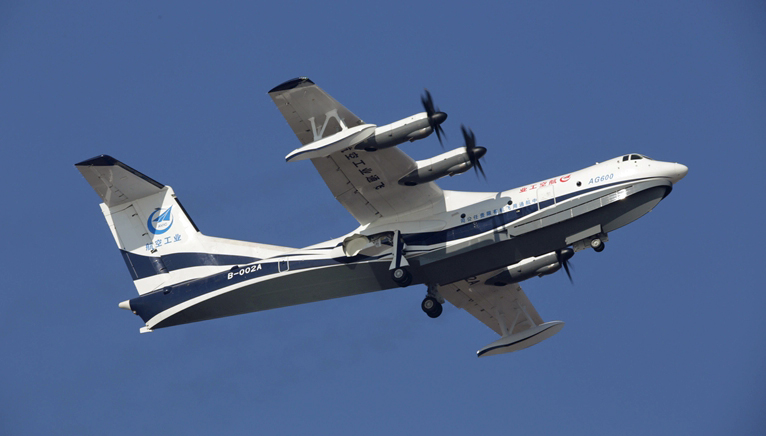It’s the second largest amphibious aircraft in the world after the Beriev A-40. Mission Includes Maritime Security, Search and Rescue and Firefighting.
The impressive AVIC AG600 long-range maritime security and patrol amphibious aircraf made its first flight from land at the Jinwan Civil Aviation Airport in Zhuhai, Guangdong, China on Dec. 24, 2017. The large, four-engine turboprop aircraft, with a wingspan of 127-feet, flew for about one-hour according to Chinese state media. It is comparable in size the jet-powered twin-engine P-8 Poseidon maritime patrol aircraft but adds the capability to land and take off in the open ocean, even in relatively heavy seas. The take-off was broadcast live on television in China. The aircraft returned to significant fanfare including planned celebrations to publicize the event.

Large, long range “flying boat” amphibious aircraft have a history of utility and success in the region, with Japan often leading the way with flying boat designs since WWII and continuing into modern aviation with their recent large, four-engine ShinMaywa US-2 and previous flying boat, the Shin Meiwa US-1A maritime patrol aircraft. Because of the region’s dependence on maritime trade and territorial disputes over small islands, the role of these aircraft has become particularly relevant. In civilian culture the aircraft and their crews take on mystic relevance because of their guardianship of sailors at sea and their ability to swoop down from the sky and save doomed men adrift in the open ocean.
China’s, Xinhua news agency broadcast that the aircraft was the “protector spirit of the sea, islands and reefs,” attesting to its security role along with an increasing environmental surveillance role to protect endangered reef areas from poaching of sharks and pollution.
The aircraft can also fill large onboard water tanks when floating on surface for fighting fires both onboard ships and on land. The aircraft can fill its onboard firefighting tanks with 12-tons of water in only 20 seconds.
The AG600’s chief designer, state aviation engineer Huang Lingcai, was quoted in the official China Daily earlier this month as saying the aircraft can make round trips without refueling from the southern island province of Hainan to James Shoal, a disputed area claimed by China but located close to Sarawak in Malaysia.
There are currently 17 outstanding orders for the AG600 from Chinese government departments and Chinese companies. Long un-refueled operating range and endurance is a key selling feature of the AG600, with a maximum flight range of 4,500 km (2,800 miles) and a maximum take-off weight of 53.5 tons. It can carry a large passenger and crew compliment of up to 50 personnel.









